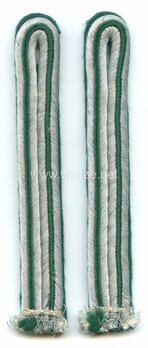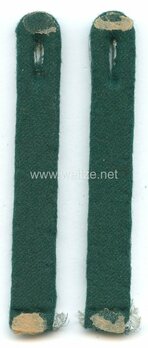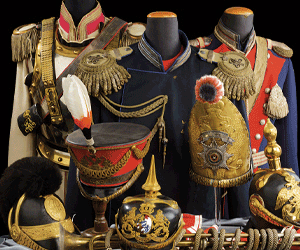SHD Zugführer Shoulder Boards
SKU: 56.GOR.03.02.01.02.005
Estimated market value:


Estimated market value:
Attributes
History
Air raid protection organisations existed during the time of the Weimar Republic in the 1920s. However, in preparation for a coming war, a greater need for a centralised organisation under NSDAP control arose. It was established mere months after the NSDAP took control of Germany. The Reichsluftschutzbund (National Air Raid Protection League) or RLB was founded on April 29, 1933 under the control of Hermann Göring as Minister of Aviation. Naturally, its leader, as well as the nature of the organisation’s tasks, meant that the RLB would always have close ties to the Luftwaffe. All previously founded air raid protection organisations ceased to exist or were forcefully absorbed into the RLB.
The RLB’s function was to train the public on how to prepare for and deal with enemy air raids, and act as a supervisor of civil protection and defense, for both private homes and for places of work. Therefore, the RLB’s focus was split up into what was referred to as Selbstschutz (self-defense) for homes and Erweiterter Selbstschutz (extended self-defense) for places of work. Air raid protection of industry that was deemed essential to the war effort was referred to as Werkluftschutz (Factory Air Raid Protection) or WLS.
The core of the organisation was made up of high-ranking Luftwaffe officers (the RLB leader was always a Luftwaffe General) and a number of full-time salaried RLB members. These professional RLB members made up only a minority of the organisation, since the vast majority of members were, in fact, volunteers. Eventually, a law passed on June 26, 1935 made it a legal duty for almost everybody to receive training by the RLB.
In May of 1937, the Sicherheits- und Hilfsdienst (Security and Assistance Service) or SHD was founded. This was meant as a sister organisation of the RLB made up of professionals rather than amateurs, including firefighters, medical personnel, and specialist troops like public utilities repair service, gas decontamination service, or salvage crews.
At the same time, the Luftschutzwarndienst (Air Raid Warning Service) or LSW was founded. It was intended as an intermediary between the Flugmeldedienst (Flight Message Service) and the air raid protection organisations. The Flugmeldedienst was responsible for spotting enemy aircraft and determining their likely targets, so the population could receive a warning before an attack was carried out.
The SHD was split in the spring of 1942, with the Luftwaffe taking control of its mobile (motorised) units, and the Police taking control of its static units under the name of Luftschutzpolizei (Air Raid Defense Police).
The water-related units were formed into a new organisation, the Wasserstraßenluftschutz (Waterways Air Defense) or WSL. This organisation was entirely separate from and not affiliated with the Wasserschutzpolizei, the Water Protection Police. The WSL’s creation was officially announced on June 1, 1942.
Until early 1940, ranks in the SHD were indicated with green armbands displaying different amounts of white stripes. In March of 1940, narrow dark green shoulder boards were introduced instead.
Contrary to the RLB, SHD shoulder boards were worn on both shoulders.
Abteilungsleiter wore shoulder boards in the form of a braid, made up of silver-coloured bullion wire on the outside and dark green in the centre, with an additional gold-coloured metal pip in the form of a four-sided star. Abteilungsführer wore the same shoulder boards, but without the pip.
Bereitschaftsführer shoulder boards feature two straight silver-coloured cords with a dark green centre and two gold-coloured pips, while Oberzugführer wore only one pip, and Zugführer wore no pips.
The rank of Oberzugführer was introduced on August 1, 1941.
Stabsgruppenführer shoulder boards feature dark green backing with silver-coloured piping and two silver pips. Hauptgruppenführer wore only on pip, and Innendienstleiter wore no pips.
The ranks of Stabsgruppenführer and Hauptgruppenführer were introduced on August 1, 1941. The rank of Innendienstleiter was discontinued on August 1, 1941.
Gruppenführer wore dark green shoulder boards with two silver pips, while Truppführer only wore one pip, and members in the lowest rank of SHD-Mann wore plain dark green shoulder boards.
LSW members wore the same shoulder boards, except that some ranks were named differently. SHD-Bereitschaftsführer were LSW-Warnzentralenführer (renamed to Hauptführer in December of 1943) and SHD-Abteilungsführer were LSW-Warnzentralenoberführer (renamed to Stabsführer in December of 1943). There was no LSW equivalent of the SHD-Abteilungsleiter rank.
In mid 1943, Staff of LSW Replacement and Training Depots were ordered to wear a letter “L” on their shoulder boards, which was in gold for Officers and in silver for lower leader ranks.
Also in 1943, the star-shaped metal pips were discontinued and replaced with braided yellow rank “bars” or “slides”.

Versions
$75 USD


Comments
Sign in to comment and reply.


Scroll Top